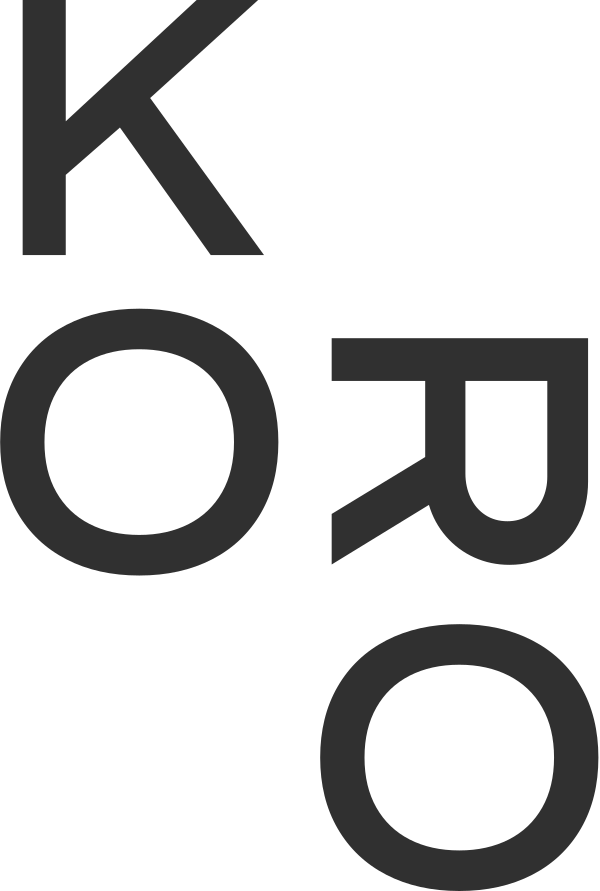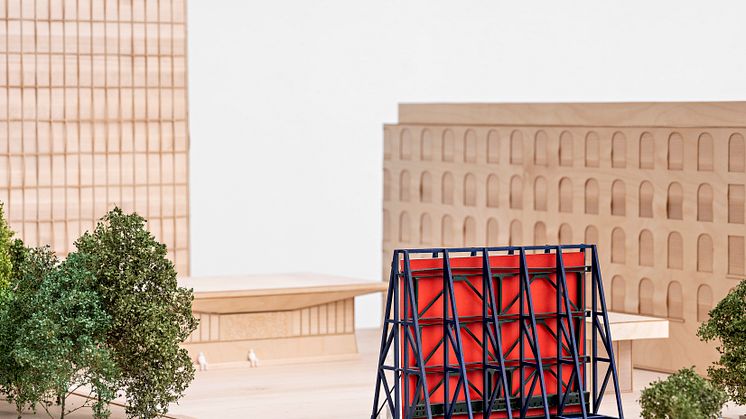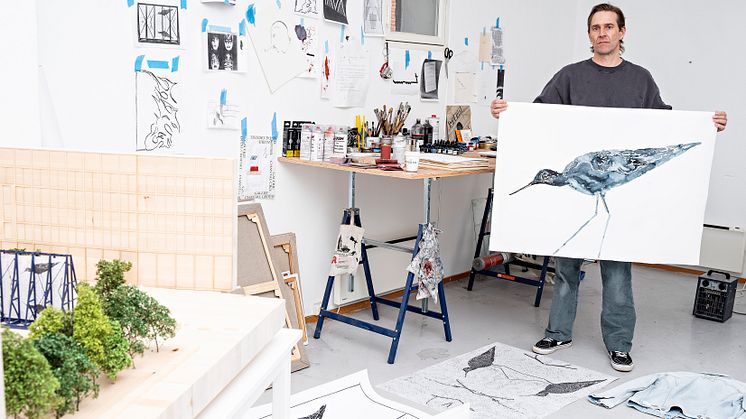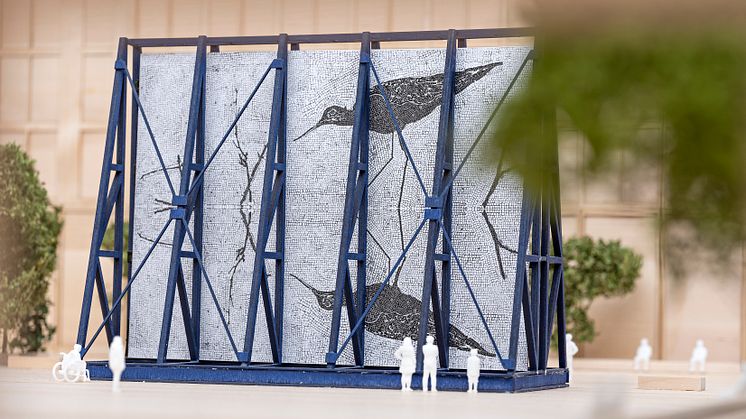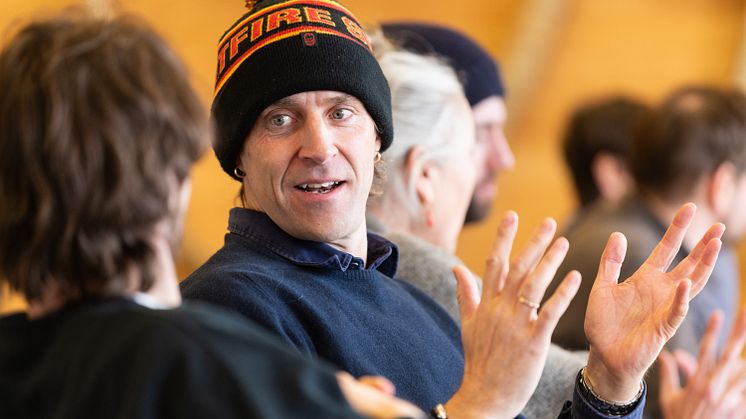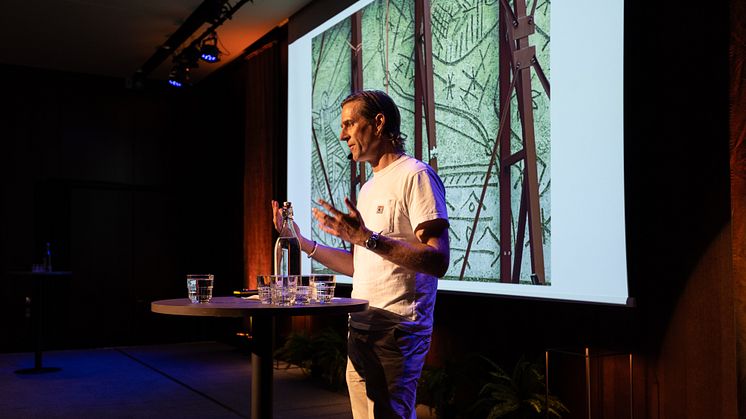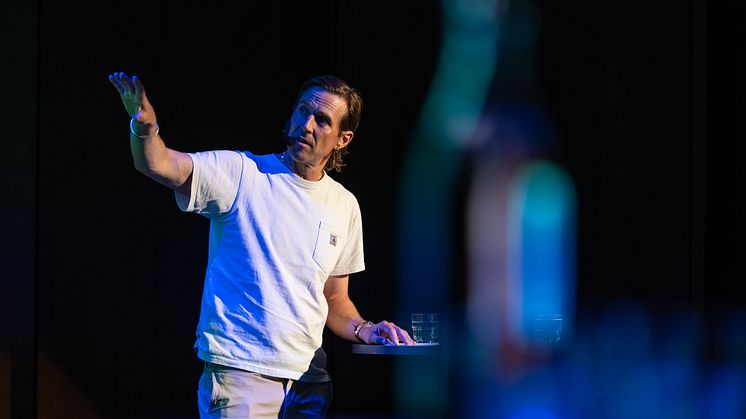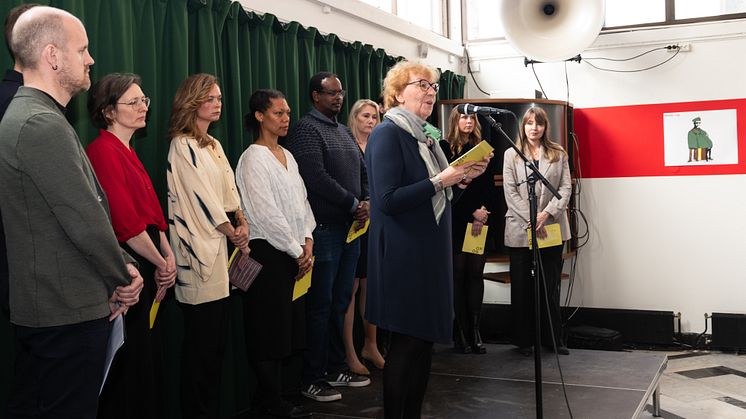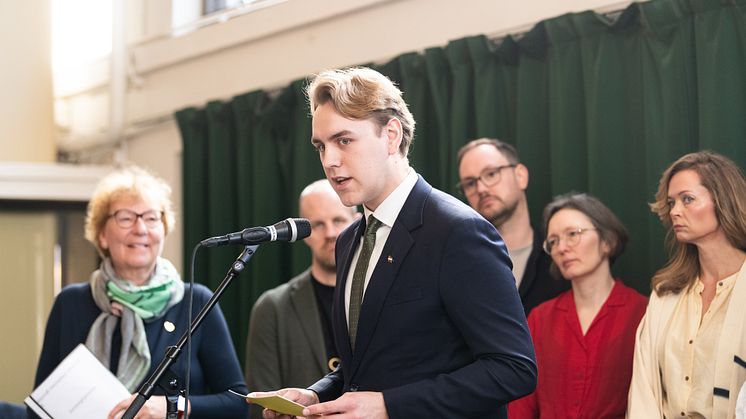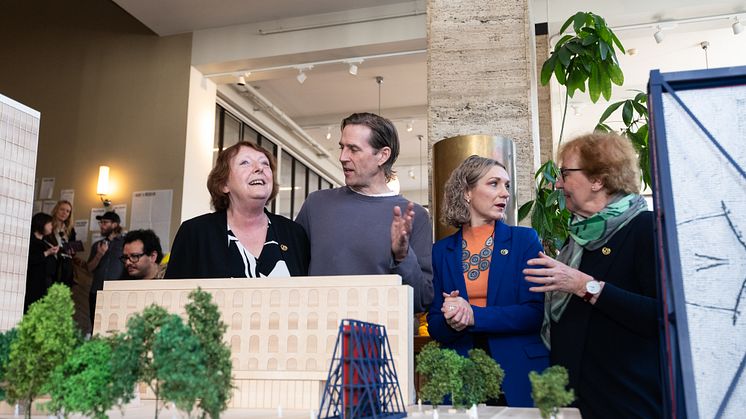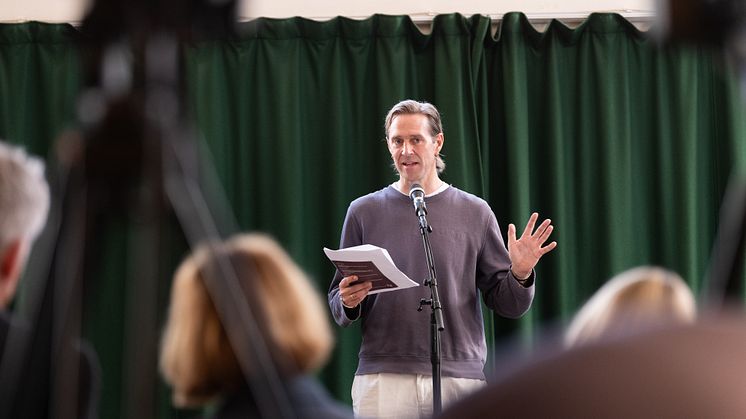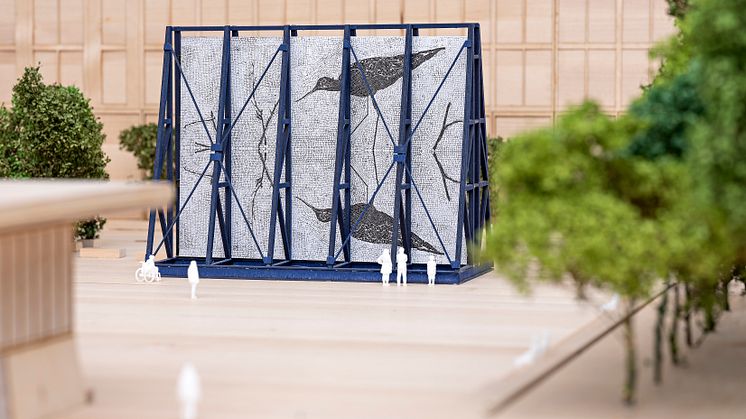
Pressemelding -
Norwegian Artist Matias Faldbakken Selected to Make a National Memorial for 22 July in Oslo, Norway
With his proposal titled Upholding, the Norwegian artist Matias Faldbakken has won the international competition to design the National 22 July Memorial in the new Government Quarter in Oslo, Norway.
KORO (Public Art Norway) has overseen the competition. The multi-round selection process was carried out by a diverse jury of eleven members.
The decision was announced on Tuesday, 8 April 2025, during a public event at the Kunstnernes Hus gallery in Oslo.
The minister of digitalisation and public governance, Karianne Tung, the jury chair and former mayor of Oslo, Marianne Borgen, and representatives from the Labour Party’s youth wing (AUF) and the National 22 July Support Group were present at the announcement.
The announcement concludes a three-year-long process which included an international open call and a thorough competition in two rounds, as well as a series of public seminars.
In May 2022 KORO received the commission to organize the competition to create a new national memorial from the Ministry of Local Government and Regional Development (KDD), now the Ministry of Digitalisation and Public Governance (DFD).
“I am pleased that the jury has today selected a worthy winner to design the National 22 July Memorial Site in the Government Quarter,” says Karianne Tung, the Norwegian minister of digitalisation and public governance. “The memorial site will be a place to remember those who were killed during the terrorist attack, as well as the suffering inflicted on the bereaved, the survivors, and all others who were affected. It will become an important symbol that our democracy withstood even the gravest threat.”
Democratic resilience
A diverse jury chaired by Marianne Borgen has thoroughly assessed all the proposals, carried out a multi-round selection process, and chosen the winner of the competition. According to the jury, Matias Faldbakken’s Upholding tells a compelling story about how our common values are formed, in the present, past, and future alike, and also about the structures we establish to manage, sustain, and negotiate these values.
Upholdingis a powerful response to 22 July and creates a physical manifestation of democracy’s vulnerability and strength,” notes Marianne Borgen, the jury chair. “As a whole, the rig and the mosaic allude strongly to both sites affected by the terrorist attack – the Government Quarter in Oslo and the island of Utøya. The memorial site will also be a place of grief and heartache. Faldbakken’s work evokes a feeling of shock and loss, even as it provides space for peace and reflection.”
The jury believes that Upholding will spur public engagement, interest, and wonderment and thereby promote a national conversation.
“The work is immediate and powerful, and it may be regarded as a reminder of the never‑ending effort required, and the responsibility we all have, to preserve democracy and maintain and uphold democratic resilience.”
Monumental and caring
Matias Faldbakken’s Upholding is based on re-erecting the large steel rig that was built to cut out and relocate Pablo Picasso’s artwork The Fishermen from the demolished Y-block to the new A-block. In this version, the rig will be filled with a monumental mosaic made of stone.
The mosaic’s imagery is taken from the island of Utøya – a drawing of a small wader and some reeds and twigs reflected in the waters of the Tyrifjord. The other side of the rig will show the pattern of the braced frame once used to hold The Fishermen and become a geometric relief painted in deep blue, deep green, and vivid red.
The rig and the mosaic will act as a link between the two scenes of the terrorist attack, the Government Quarter and Utøya.
Faldbakken regards it as a great honour, and not least a tremendous responsibility, that the jury has chosen Upholding. In the further process, he intends to work closely with bereaved family members and others affected by the terror attacks in order to complete the memorial site.
“My motivation has been to create a work of art for those who were killed that day,” Faldbakken says. “At the same time, the work will embody much of the conflicted national history that followed the terror attack. The sculpture is meant to be experienced as large and insistent, and its enormous weight must be equivalent to the weight this event has had in Norway. The mosaic, for its part, will be intimate and warm, with tactile qualities and imagery that alludes to things that are small, fragile, and irreplaceable.”
Faldbakken is just as interested in what a sculpture or a work of art does, as in what it says.
Above all, his proposed sculpture is an object that embodies feelings of shock, loss, and heartache. But as the artist points out, the work articulates not only despair, but also peace, care, and vitality. The various elements – the mosaic, the imagery, the steel rig, and the bold colours – become emotional entities in a concrete form. The sculpture on the square will be a physical experience.
The further process
Throughout this commission, KORO has worked toward an inclusive and participatory process, facilitating extensive involvement and dialogue with interested parties, allowing space for reactions and encouraging a robust public conversation. KOROs mandate included a particular responsibility for involving stakeholders such as the bereaved, survivors and those directly impacted, including the Norwegian support group after the July 22 attacks, the Norwegian Labour Party’s youth wing (AUF), ministries, ministry employees and neighbours.
The director of KORO, Øystein Strand, extends his thanks to the various artists and architects who have participated in the competition, as well as to the jury for their excellent work.
“Our job now is to finalize a preliminary project, based on the winning proposal, that will be delivered to the Ministry of Digitalisation and Public Governance before the summer,” Strand says. “The preliminary project will create a basis for the ministry to assess the matter and make its decision. Only then will the task that KORO received nearly three years ago be completed. KORO would also be happy to contribute in the next phase of the work to realize a permanent memorial site in the new Government Quarter,” Strand says.
Background
The bombing in Oslo and the massacre on the island of Utøya on 22 July 2011 were the worst terrorist attacks in modern Norwegian history. Eight people were killed in the Government Quarter in central Oslo, and sixty-nine were shot and killed at Utøya, an island northwest of the capital that is the historical home of a summer camp organized by the Norwegian Labour Party’s youth wing (AUF). Most of the victims were young people. Many more were injured and subjected to life-threatening danger, both in the Government Quarter and on Utøya. The damage was enormous.
The attacks were politically motivated, carried out by a Norwegian right-wing extremist targeting democratic institutions, the Labour Party in particular, and politically involved youth. The terrorist’s atrocities were unprecedented in Norwegian history.
In 2012, the government decided to establish two official memorials, one in connection with Utøya, the other in the Government Quarter in Oslo. The permanent memorial at Utøyakaia, the mainland berth for the ferry to Utøya, opened in the spring of 2022. A temporary memorial opened in the Government Quarter in 2018, which Upholding by Matias Faldbakken will replace.
As a result of the terrorist attacks, Norway is currently building a completely new Government Quarter in Oslo. The memorial will become a key part of the new quarter and will stand as a lasting testimony to those who lost their lives during the terrorist attacks on 22 July 2011. The site will also be part of Norwegian society’s continuous efforts to preserve democracy and counteract similar attacks in the future.
The competition for the new memorial was announced in the fall of 2023 and received 220 applications. Ten applicants, both individual artists and architects as well as groups, advanced to the first round and submitted their sketch proposals in June 2024. Three of the participants were chosen as finalists and submitted their finished proposals to the jury in January 2025. Today, the artist Matias Faldbakken was announced as the winner.
The jury has consisted of the following members:
- Marianne Borgen (jury chair, b. 1951), Oslo’s mayor from 2015 to 2023
- Mohamed Abdi (b. 1986), teacher and author
- Regitze Schäffer Botnen (b. 1994), national board member of the 22 July Support Group
- Mathias Danbolt (b. 1983), professor at the University of Copenhagen
- Lena Fahre (b. 1968), director of the 22 July Centre
- Ingeborg Hjorth (b. 1977), head of research and development at the Falstad Centre
- Nora Ceciliedatter Nerdrum (b. 1978), head of Art section / curator at KORO
- Camille Norment (b. 1970), artist
- Trude Schjelderup Iversen (b. 1974), senior curator at KORO
- Fabian Wahl Sandvold (b. 2000), AUF national board member
- Øystein Rø (b. 1978), architect and partner at Transborder Studio
About Matias Faldbakken
Matias Faldbakken (Norwegian, born 1973 in Hobro, Denmark) works as an artist and a writer in Oslo. He has exhibited at the Documenta 13 (2012) and represented Norway in the Nordic Pavillion at the Biennale di Venezia (2005). He has had solo exhibitions at WIELS, Brussels; Le Consortium, Dijon; Fridericianum, Kassel; Museum Boijmans van Beuningen, Rotterdam; The National Museum of Art, Design and Architecture, Oslo and The Astrup Fearnley Museum of Modern Art, Oslo. He has done large scale commissions for Norwegian Scenic Routes (Rondane), Parc de Tuileries in Paris, The Bass Museum, Miami and Hamar Rådhus.
Since 2001 Faldbakken has published six novels. As a writer he has won the Bjørnson Prize, the Norwegian Critic’s Prize, The Norwegian Radio’s Literary Award, The Oslo Price and ITB Buch Award. He has been shortlisted for the Nordic Council Literature Prize and IMPAC—Dublin Literary Award. His six novels are translated into more that 18 languages
Related links
Kategorier
KORO is Norway’s national body responsible for curating, producing and activating art in public spaces. KORO manages an extensive collection of some 8.000 artworks accessible at around 1.000 sites throughout Norway and abroad. In addition, KORO is a national center for research and knowledge development within the field of public art.
